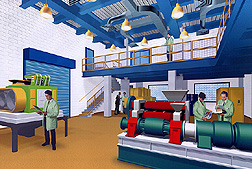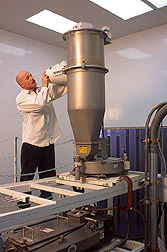Pilot Plants Push Tech Transfer
|
|
|
 At the NCAUR pilot plant in Peoria, Illinois, chemists Terry Isbell (left) and Steve Cermak prepare meadowfoam derivatives for use in hair conditioners. (K8777-2) |
In the 1930s, as advances in farming ushered in an age of agricultural product surpluses, USDA countered with plans for establishing four research centers for developing new uses for the surpluses. Since the 1940 opening of the utilization centers, ARS has patented hundreds of inventions and processes for making use of farm products.
Highlights include launching the antibiotics industry, making frozen orange juice, developing edible oil and other products from soybeans, creating a durable-press finish for cotton fabrics, and making leather processing more environmentally friendly. |
|
 Chemical engineer Mike Kozempel tests a poultry pasteurization process at the renovated ERRC pilot plant in Wyndmoor, Pennsylvania. Recent renovations will help expand research on pasteurization of foods. (K8972-1) |
A secret to those successes and future ones may have been expressed best by a former center director: "Employ the most competent scientists you can find, supply them with the best scientific instruments and equipment, explain your research goals, and then back off and let them work."
The director's philosophy is alive and well, thanks partly to some 1998 federal legislation (P.L. 105-185). Under this measure, industries can team up with ARS scientists to further evaluate, in larger settings generally called pilot plants, research that in the laboratory shows promise for new commercial biobased products. The centers at Albany, California; New Orleans, Louisiana; Peoria, Illinois; and Wyndmoor, Pennsylvania, are welcoming the new opportunities with pilot plant and laboratory renovations that began in 1997 and will continue for the next 5 years. The pilot plant wing of the National Center for Agricultural Utilization Research (NCAUR) at Peoria now includes four new two-story chemical and biological processing bays designed with the flexibility needed as one project is replaced by another. The facility offers the opportunity to test processes and equipment on a scale large enough to make economic assessments, says Peter B. Johnsen, NCAUR director. "Until now, some inventions had too often fallen into a 'death valley'—never to be heard from again." Renovated pilot plants will serve as a bridge between invention and commercialization.
|
|
 A look into the future: When remodeling at the SRRC's Oilseed and Grain Processing Pilot Plant in New Orleans has been completed, chemical engineers and others will work in a setting like this. (K8998-1) |
Commercial partners in the new endeavors may enter through cooperative research and development agreements (CRADAs) under a 1986 amendment to the Stevenson-Wydler Technology Innovation Act of 1980 or under funding arranged through the Biotechnology Research and Development Corporation—USDA's Small Business Innovation Research Program.
Through the risk-sharing CRADAs, the private sector may provide some of the capital, manufacturing and production equipment, and technical support needed to commercialize ARS technologies. In two of the first CRADA's involving pilot plant research, NCAUR scientists used the new facilities to help explore the potential for new industrial products derived from vegetable oils. In an earlier CRADA, the NCAUR scientists had supplied researchers of Lambent Technologies Corporation, in Skokie, Illinois, with laboratory-made compounds called estolides. Lambent produced the estolides—made from oleic acid of sunflower oil—for testing as components of motor lubricants and found two that just might work if modified properly for pilot-scale production. Shortly after the NCAUR pilot plant was completed, scientists were able to control processing conditions in the scale-up under a new CRADA much as they had in the laboratory. The success led to a lubricant patent issued to USDA and the company. The researchers then proceeded to make up to 60 gallons of the modified estolides in the pilot plant. The company is now using the estolides in formulation research and providing samples to client companies for testing.
|
|
 At the WRRC pilot plant in Albany, California, research associate Artur Klamczynski loads wheat flour in the feed hopper of a twin-screw extruder during preparation of cereal snacks. (K8795-4) |
Similarly the Peoria researchers made estolides from the oil of a new crop, meadowfoam. These estolides had shown potential as ingredients for personal care products. The Fanning Corporation, Chicago, Illinois, had the formulation expertise and the facilities for testing.
Through cooperative research on pilot-scale manufacturing of the meadowfoam estolides, another joint USDA-industry invention was patented. Shampoos containing meadowfoam estolides produced at NCAUR are now being tested in salons of some of the Fanning Corporation's client companies. In other pilot-stage research at Peoria, scientists will focus on production of biological control agents, as well as ethanol and other fermentation products. They will also conduct research on food ingredients and on a biodegradable insecticidal decoy designed to reduce the need for pesticides in orchards. At the Eastern Regional Research Center (ERRC), Wyndmoor, Pennsylvania, the pilot plant wing required less renovation to meet 21st century standards than did its sister laboratories. The upper level, used only for new foods research, needed more modern electrical and plumbing systems. A recently remodeled lower level now has two new modules: one for biochemical research on goals such as increasing efficiency of ethanol production and one for research on improving food safety. Until now, food safety research has been mainly on poultry meat, says ERRC director John P. Cherry. "The renovations will help us expand research on pasteurization of solid foods such as fruits and vegetables and thermally sensitive fluids such as eggs." ERRC has a dairy pilot plant that includes facilities for milk processing, cheese making, encapsulation and extrusion, and spray drying. The facilities allow researchers to develop new products with unique functional properties like low-fat mozzarella cheeses for pizza making, encapsulated highly flavored butterfat fractions for the pastry industry, and extruded high-protein foods made with grain and dairy proteins. A bioengineering pilot plant with fermentation capabilities is developing new cost-effective downstream processing technologies for ethanol and coproducts technologies. ERRC also has a unique hides-to-leather tannery—the only one like it in the United States—that is used extensively in collaborative work with the industry to solve problems through research. At the Southern Regional Research Center (SRRC), New Orleans, Louisiana, renovations began with the recently completed modernization of chemical wing laboratories. As in planned changes at NCAUR, these projects include remodeling of electrical and plumbing systems to provide the flexibility to meet changing research and technology needs. The improvements were also designed to help ensure the safety and health of ARS employees and users of the new technologies. The SRRC pilot-plant wing is getting an overhaul that's expected to be complete by spring 2001. The renovations will bolster research on the safety and quality of foods and on development of new food and animal feed products. "Our scientists plan to use the pilot plant to develop new corn and rice milling processes that will help foods retain nutritional qualities," says SRRC director John P. Jordan. Scientists at SRRC will also use the pilot plant to further develop rice food products that have had their starch modified to be digested slowly. Such foods may help diabetics manage their levels of blood glucose. Other food research at SRRC deals with the processing and storage of fresh-cut fruit and with the detection of off-flavors in catfish. Off-flavors in many cases develop as fish take in geosmin and 2-methylisoborneol—muddy-smelling chemicals produced by microbes. Remodeling of the Western Regional Research Center's four-story, 20,000-square-foot pilot plant is under way and should be complete in about 6 years. Today, in the food-processing section of the plant, researchers use a highly instrumented, twin-screw extruder to create healthful new fruit- or vegetable-based foods. Others extract natural chemicals—from citrus—that have been shown to fight cancer. The pilot plant in Albany, California, has been the home of other interesting investigations, including development of edible coatings to keep fruits and vegetables fresh. The center's pioneering research to improve processing of rice bran—the nutritious brown layer that WRRC scientists showed can lower cholesterol—also began here. The industrial processing wing housed early trials of a unique, now-patented process for making wheat-starch-based concrete. "Our remodeled pilot plant," says Center Director James N. Seiber, will be ideal for a host of other projects that require equipment that we can't squeeze into our existing labs. We'll have the capacity for new food safety and food processing studies with lettuce, sprouts, or poultry, for example, or for tests of biodegradable packaging materials made from wheat starch. We'll be able to conduct onsite tests to explore new uses of crops like guayule—a desert shrub that our patented research has shown is a promising new domestic source of hypoallergenic natural latex. And we may use the pilot plant to expand our experimental processing of insect diets for biological control. "Our pilot plant has served us well," says Seiber. "The new improvements we're planning will make it high tech and up to date."—By Ben Hardin, Agricultural Research Service Information Staff. This research is part of New Uses, Quality, & Marketability of Plant & Animal Products, an ARS National Program (#306) described on the World Wide Web at http://www.nps.ars.usda.gov/programs/cppvs.htm. For information on people mentioned in this article, contact Ben Hardin,USDA-ARS Information Staff, 1815 N. University St., Peoria, IL 61604; phone (309) 681-6597, fax (309) 681-6690. |
|
"Pilot Plants Push Tech Transfer" was published in the August 2000 issue of Agricultural Research magazine. |
|






